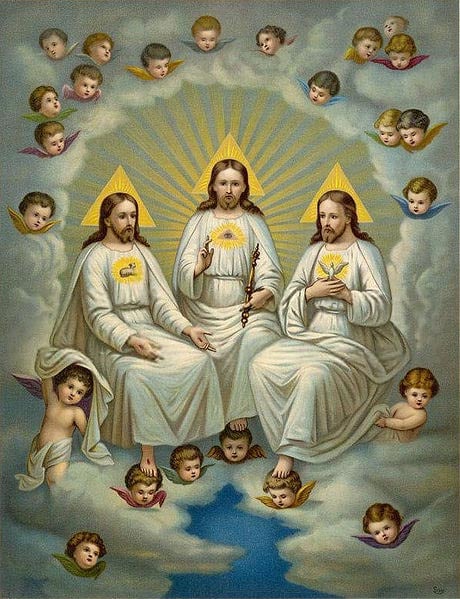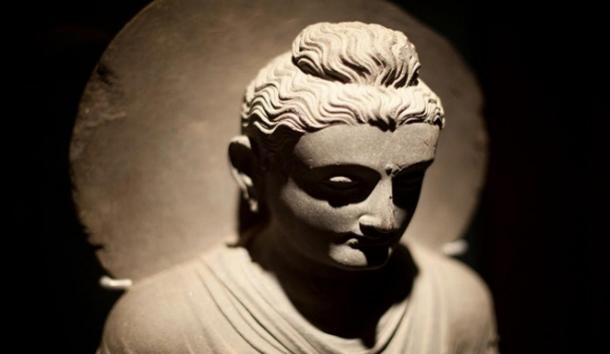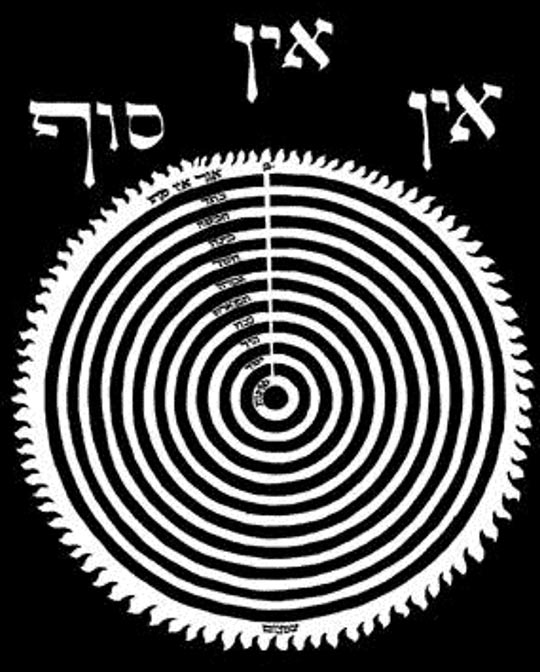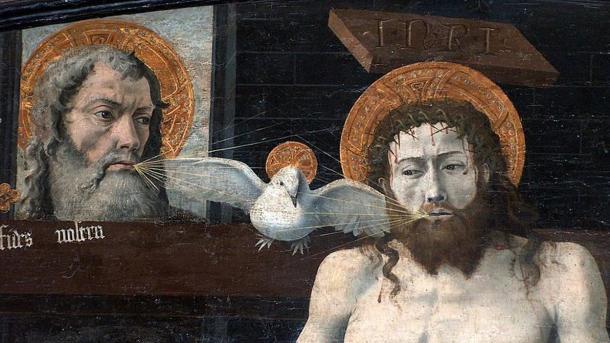“In the name of the Father, the Son and the Holy Spirit…”
The concept of a Trinity or triadic nature of the divine has been a part of our psyche for thousands of years, and has appeared in creation tales, myths, religious writings and holy texts the world over. Yet to this day, the Trinity is always thought of as having its origin in Roman Catholicism—most notably at the Council of Nicaea in AD 325, the first ecumenical council of Christian bishops where the consensus of beliefs was decided upon for all of Christendom, including the Trinity as the three-fold nature of the persona of God.

A representation of the Christian Holy Trinity. The persons of the Trinity are identified by symbols on their chests: The Son has a lamb, the Father, an Eye of Providence, and the Spirit a dove. ( Public Domain )
Yet references to the Trinity or something like it occur in many major and minor religions. Scholar Elaine Pagels studied sacred texts and wrote in The Gnostic Gospels (1979) that early Christian concepts of the Trinity were molded from Judaic terminology for the description of a genderless God, later “masculinized” by the Christians. In the ninth century AD Celtic philosopher Erigena challenged Augustine’s rather anthropomorphic Trinity view of Three-Persons-in-One-God with his far more philosophical views of God as Nothing and Everything.
According to Karen Armstrong in her seminal A History of God (1994), Christian church leadership struggled to maintain control of the doctrine it would present to the public, including a comprehensible interpretation of the Trinity as the personas of God, despite the resistance of those not capable of seeing God as any structure or “personage.” This struggle continues today in churches where the concept of the Trinity presents a vague understanding of who God is and why God must have three different “faces.”

Triple-formed representation of the Greek goddess Hecate. ( Public Domain )
The Trinity has remained one of the most elusive of holy mysteries in the body of Christianity, and one that draws debate in Catholicism even today as modern church-goers seek a more foundational understanding of why God’s “person” is three-fold and not singular, yet containing all. All is One. One is All.
The Trinity in Global Religions
Interestingly, Judaism would reject the Trinity based on their belief that giving Jesus divinity at all was blasphemous. To the Jews, Jesus was a man, not a divine persona or aspect of God. Islam had its own Trinity in the Father, the Son and Maryam or Mary and is the only religion to include a feminine aspect of the divine Godhead.
Trinities appear in eastern traditions as well. Modern translations of The Tao Te Ching (1996); The Essential Kabbalah (1995); The Bhagavad-Gita (1986); and The Tibetan Book of the Dead (1994) all serve to provide unusual insights into how this concept of a three-fold nature of reality, and our role in it, is seen and understood. Eastern traditions remove the aspect of a Godhead, or divine figure described by the Trinity.
In The Tibetan Book of the Dead, the “Three Bodies of Buddhahood,” present triadic levels of existence. A person is responsible for his or herself on all three levels. As Buddhahood, the triad becomes the Three Buddha Bodies; ordinary body becoming the Emanation Body, speech the Beatific Body, and the mind the Truth Body. The three Buddha Bodies correlate with body, mind and spirit, and we might go so far as to say with the concept of the Father as God, the Son as personhood and the Holy Spirit as the process by which a person becomes one with God, and also suggest a more unified and process-oriented explanation for the Trinity.

Statue of Buddha. (Ed Schipul /CC BY-SA 2.0 )
We even see parallels in The Tao Te Ching in the “Three Jewels” or “Three Treasures” of the Buddha, the Dharma (law or action) and the Sangha (community). The Jains recognize the Trinity of samyag-darsana (correct insight), samyag-jnana (correct knowledge), and samyag-caritra (correct conduct).
In The Bhagavad-Gita , there is the threefold nature of the Self, as told to Arjuna by the Hindu God Krishna, and in The Kabbalah , the mystical branch of Judaism, we find similar concepts of Holy Breath as necessary for union with the Divine, and the three original emanations from Ein Sof , All That Is – Nothingness, Wisdom and Understanding. These three emanations serve as the basis upon which all other existence upon the Tree of Life was formed and the essence of which followers were urged never to try to understand. Perhaps the vague nature of the Catholic Holy Trinity is something followers are not meant to understand either, at least not on a conscious level.

Representational image of Ein Sof and angelic hierarchies in Kabbalah. ( Public Domain )
Vietnamese Buddhist monk Thich Nhat Hanh in Living Buddha, Living Christ (1995) compares Western and Eastern concepts of the Trinity. After meeting with Christian clergy, Hanh remarked, “I told the Priest that I felt all of us have the seed of the Holy Spirit in us, the capacity of healing, transforming, and loving. When we touch that seed, we are able to touch God the Father and God the Son.”
Hanh powerfully presents the idea of the Trinity as the process of direct knowing of the Divine that transcends all religious labels and names. He claims the safest way to approach the Holy Spirit is through the concept of mindfulness and that “someone animated by the energy of the Holy Spirit…is the Son of Man and the Son of God…” a concept not alien to Buddhists who are familiar with the nature of non-duality.
The Buddhist Trinity, as Hanh calls it, of Buddha, Dharma and Sangha presents the Trinity as accessible to all followers.

Buddhist symbol representing the Three Jewels – Buddha, Dharma, Sangha. (Christopher J Flynn/ CC BY-SA 4.0 )
Many Catholic churches continue to use the Holy Spirit as a tool to hold over the heads of their followers like a threatening specter that picks and chooses whom it will “descend” upon. Catholicism separates believers from the Godhead, whereas eastern concepts unify believers with the breath of life itself and presents a trinity more focused on “process” not “persona.” Buddhism teaches believers that spirit is available to everyone; that we are all infused with the power of the holy breath.
3: The Perfect Number
The number three is considered the perfect number, the unifier of dualities. Kabbalists refer to the number three as the number of integration. Human beings are three-fold in nature: body, mind and spirit. Perhaps our ancient ancestors understood the triune nature of existence on the deepest level of the subconscious, which then translated into symbols and archetypes found in our origin stories, myths and religious texts.
Perhaps the Trinity itself is nothing but a symbol for the process of creation itself, and not the actual persona of the divine, which is why it has continued to cause so much frustration and debate in the Catholic Church. They are, to put it simply, looking for God in all the wrong places.

The Catholic Trinity, circa 1450, France. ( Public Domain )
If we look at the Trinity as a process of union with the All, then perhaps God the Father is the Creator, the Son is Creation, and the Holy Spirit is the holy breath that brings life to the physical manifestation, thus, the process of Creating.
Creator Creating Creation. Father. Holy Spirit. Son. And because we are said to be made in the image of the divine, we ourselves are walking, talking trinities; creators creating creation.
Marie Jones and Larry Flaxman are co-authors of “ The Trinity Secret: The Power of Three and the Code of Creation ”, exploring the concept that the Holy Trinity is not limited to a single religion or belief system.
Featured image: Deriv; Statue of Buddha (Flickr/ CC BY-SA 2.0 ), Triskele Symbol, Ein Sof
By Marie D. Jones and Larry Flaxman
Updated September 21, 2021.
References
Armstrong, Karen. 1994. A HISTORY OF GOD. New York, New York: Alfred A. Knopf.
Hanh, Thich Nhat. 1995. LIVING BUDDHA, LIVING CHRIST. New York, New York: Riverhead Books.
Jones, Marie D. and Larry Flaxman. 2011. TRINITY SECRET. Franklin Hills, New Jersey: New Page Books.
Mair, Victor H. 1990. TAO TE CHING – MYSTICAL CLASSICS OF THE WORLD. New York, New York: Bantam Books/Quality Paperback Book Club.
Matt, Daniel C. 1995. THE ESSENTIAL KABBALAH – MYSTICAL CLASSICS OF THE WORLD. New York, New York: Bantam Books/Quality Paperback Book Club.
Miller, Barbara Stoller. 1986. THE BHAGAVAD-GITA – MYSTICAL CLASSICS OF THE WORLD. New York, New York: Bantam Books/Quality Paperback Book Club.
Pagels, Elaine. 1979. THE GNOSTIC GOSPELS. New York, New York: Vintage Books Edition/Random House, Ltd.
Thurman, Robert A. F. 1994. TIBETAN BOOK OF THE DEAD – MYSTICAL CLASSICS OF THE WORLD. New York, New York: Bantam Books/Quality Paperback Book Club.
 RSS Feed
RSS Feed















 September 22nd, 2021
September 22nd, 2021  Awake Goy
Awake Goy  Posted in
Posted in  Tags:
Tags: 













